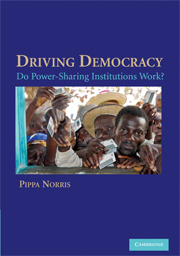Book contents
- Frontmatter
- Contents
- List of Tables
- List of Figures
- Preface and Acknowledgments
- PART I DO POWER-SHARING REGIMES WORK?
- 1 What Drives Democracy?
- 2 Evidence and Methods
- 3 Democratic Indicators and Trends
- 4 Wealth and Democracy
- PART II THE IMPACT OF POWER-SHARING INSTITUTIONS
- PART III CONCLUSIONS
- Technical Appendix: Description of the Variables and Data Sources
- Notes
- Select Bibliography
- Index
2 - Evidence and Methods
Published online by Cambridge University Press: 05 September 2012
- Frontmatter
- Contents
- List of Tables
- List of Figures
- Preface and Acknowledgments
- PART I DO POWER-SHARING REGIMES WORK?
- 1 What Drives Democracy?
- 2 Evidence and Methods
- 3 Democratic Indicators and Trends
- 4 Wealth and Democracy
- PART II THE IMPACT OF POWER-SHARING INSTITUTIONS
- PART III CONCLUSIONS
- Technical Appendix: Description of the Variables and Data Sources
- Notes
- Select Bibliography
- Index
Summary
Establishing systematic evidence to assess the impact of power-sharing arrangements is important, both theoretically and politically. Whether these arrangements serve the long-term interests of peace-building, durable conflict management, and democratic consolidation in multiethnic societies remains an open question. Despite the desirability of establishing practical guidelines for crafting new constitutions, and the extensive literature which has developed, the evidence available to compare the performance of power-sharing on democracy and the management of ethnic conflict remains limited. Several approaches have been used in previous research, including in-depth treatment of selected national case studies, historical-institutional accounts of political development within particular countries, comparative cross-sectional approaches based on analyzing a subset of democracies (Lijphart) or minorities at risk (Gurr), and analogies drawn between the experience of the legislative underrepresentation of women with that of ethnic minorities. Unfortunately this literature remains inconclusive as a result of inconsistent results, with certain limitations in each approach. Given the inherent flaws of any single method taken in isolation, this study opts for a mixed research design, combining the virtues of rich and detailed studies of contrasting paired cases with the advantages of comparing large-N time-series cross-sectional data. Understanding both the methodology and its limitations is important in order to evaluate the results, but those wishing to focus upon the meat-and-potatoes findings may wish to skip ahead to Chapter 4.
- Type
- Chapter
- Information
- Driving DemocracyDo Power-Sharing Institutions Work?, pp. 37 - 53Publisher: Cambridge University PressPrint publication year: 2008

